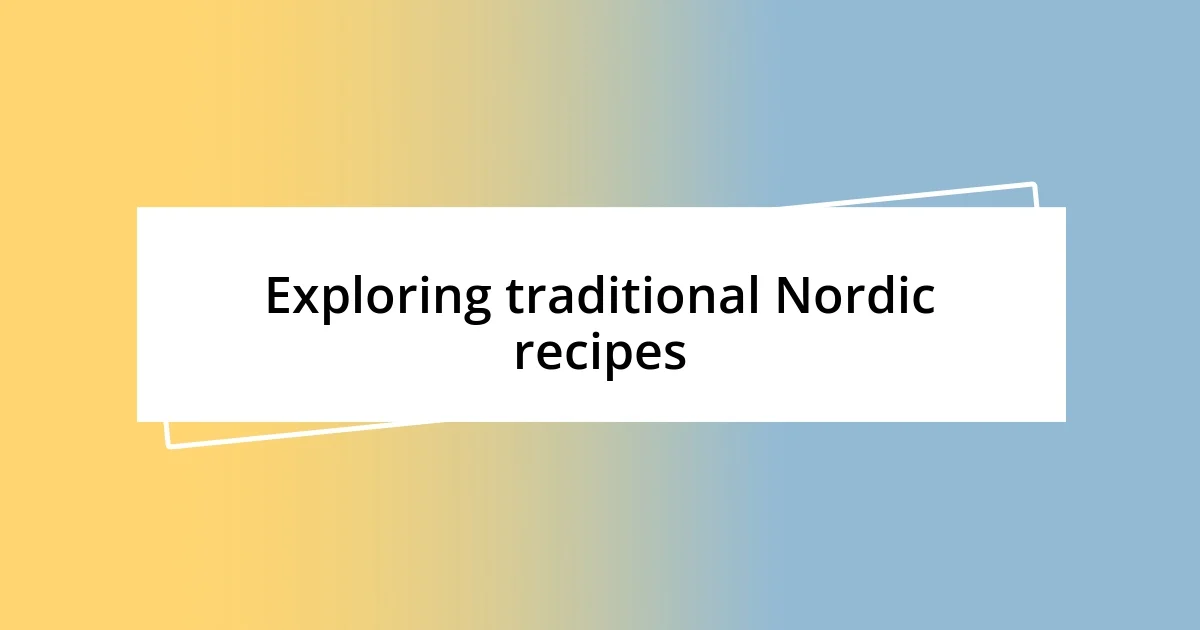Key takeaways:
- Nordic cuisine emphasizes seasonal, local ingredients, preservation methods, and creativity, transforming simple foods into flavorful dishes.
- Traditional recipes like köttbullar and gravlax celebrate Nordic heritage and encourage personalization with unique twists and local sourcing.
- Pairing drinks, setting a simple yet elegant table, and incorporating seasonal elements enhance the dining experience and connect the meal to Nordic culture.

Understanding Nordic cuisine basics
Nordic cuisine is deeply rooted in the natural landscape, which means ingredients are often seasonal and local. I remember the first time I visited a farmer’s market in Scandinavia; the vibrant displays of fresh produce, foraged mushrooms, and wild berries felt like a celebration. Have you ever tasted berries picked straight from the bush? There’s something incredibly satisfying about that connection to the earth.
The cooking methods are equally important, with a focus on preservation techniques like fermenting, smoking, and pickling. When I tried my hand at pickling herring, I found the whole process to be both time-consuming and rewarding. It made me wonder, how many flavors can we unlock by simply taking the time to preserve and honor our food?
Another key element of Nordic cuisine is the emphasis on simplicity and creativity. I often find joy in transforming basic ingredients into something extraordinary. Have you ever thought about how a simple potato can be elevated with just a touch of dill and a squeeze of lemon? It’s these little nuances that truly reflect the spirit of Nordic cooking, making it both approachable and delightful.

Gathering essential ingredients
When it comes to gathering essential ingredients for Nordic cuisine, I find myself constantly excited by the variety available. Seasonal offerings are the backbone of this culinary style, and I’ve learned to keep an eye on what’s fresh at my local market. The thrill of discovering new, vibrant root vegetables or crisp greens always fills me with curiosity. Have you ever embraced the excitement of buying something new to experiment with?
For me, utilizing local and sustainable sources has transformed my cooking experience. I recall a weekend trip to a nearby farm where I picked my own cloudberries. The sweet, tart explosion of flavor was like nothing I had ever known. It made me realize that the origins of our food are just as significant as the dish we create from it.
The balance between indigenous ingredients and those brought from afar plays a crucial role in enriching my meals. Nordic cuisine often highlights staples such as rye, lichen, and game meats, which I enjoy pairing with spices from other cultures. This fusion brings a unique twist to traditional recipes, a little something I cherish when inviting friends over for dinner. Experiencing their delight as they taste the unexpected combinations is tremendously rewarding.
| Ingredient | Source |
|---|---|
| Cloudberries | Foraged in local wetlands |
| Rye | Locally grown or imported |
| Game meats (e.g., venison) | Local hunters or farms |
| Foraged mushrooms | Seasonal forests |

Exploring traditional Nordic recipes

Exploring traditional Nordic recipes
Diving into traditional Nordic recipes has been an enriching experience for me. I recall the first time I attempted to make gravlax at home. The anticipation of watching the salmon cure with salt, sugar, and dill while I tried to resist the urge to peek every few hours was exhilarating. The vibrant colors and aromas filled my kitchen, creating a sense of celebration around the process. Have you ever felt that delightful blend of patience and excitement that comes from cooking something so deeply traditional?
Some traditional Nordic recipes I’ve come to love include:
-
Köttbullar (Swedish Meatballs): I often serve these at gatherings, accompanied by lingonberry sauce. The sweet-tart flavor balances the richness of the meatballs perfectly.
-
Rökt Lax (Smoked Salmon): This is a staple in my breakfasts. I love layering it on a slice of rye bread with a dollop of cream cheese and fresh dill; it feels both luxurious and comforting.
-
Lapskaus (Norwegian Stew): There’s something truly soul-warming about a pot of lapskaus bubbling away. It evokes memories of cozy family dinners, as the flavors meld beautifully over low heat.
-
Rømmesalat (Sour Cream Salad): This simple dish is a refreshing side I frequently whip up, mixing sour cream with fresh herbs and crisp veggies. It’s the perfect complement to richer dishes.
-
Koldtbord (Cold Table): I love creating a spread of various cured meats, cheeses, and pickled vegetables, inviting friends to indulge while enjoying vibrant conversations.
These recipes not only satisfy the palate but also connect me to the history and culture behind them, making each meal an exploration of Nordic heritage.

Cooking techniques for Nordic dishes
Cooking techniques specific to Nordic dishes often revolve around simplicity and respect for ingredients. One of my favorite methods is pickling, which I discovered during a rainy afternoon spent researching my Scandinavian roots. The vibrant colors of the veggies brightening my kitchen instantly lifted my spirits. Have you ever marveled at how a simple vinegar-brine can transform vegetables into tangy treasures? My first attempt at pickling cucumbers resulted in a crispy, refreshing snack that became a hit at family gatherings.
Another crucial technique is slow cooking, which really defines dishes like lapskaus. I recall a chilly evening when I decided to let a hearty stew simmer on low heat all day. The aromas wafting through my home were nothing short of magical, enveloping me in warmth and comfort. It’s fascinating how time transforms the ingredients, melding flavors and creating a dish that feels like a hug in a bowl. Have you taken the time to savor a meal that required patience? The love poured into that stew made every bite unforgettable.
Lastly, I’ve learned the importance of smoking, especially when it comes to fish. The first time I tried cold smoking salmon at home was filled with anticipation and a hint of nervousness. I enjoyed watching the smoke curl around the fish, dancing as it infused flavor. It was a joyful moment when I finally sampled my creation; the rich, complex taste left me wanting more. What home technique has taken your cooking to another level? Uncovering these Nordic methods has truly elevated my culinary skills and deepened my appreciation for this beautiful cuisine.

Pairing drinks with Nordic meals
Pairing drinks with Nordic meals can be an adventure on its own. I remember the first time I served a warm bowl of lapskaus to friends; I decided to pair it with a crisp lager. That choice transformed the meal into a delightful experience. The beer’s refreshing bite cut through the richness of the stew and enhanced the flavors in a way that was simply satisfying. Have you ever taken a moment to consider how the right drink can elevate a meal?
For traditional dishes like köttbullar, I often reach for a fruity red wine, like a Beaujolais. The wine’s light body melds beautifully with the meatballs, while the acidity works wonders when spooning on that tart lingonberry sauce. Oh, what a great synergy! It’s such a joy to witness how flavors interact and surprise you. Have there been times when a drink unexpectedly enhanced your food experience?
In contrast, when I indulge in smoked salmon, I typically opt for a glass of aquavit. Its herbal notes perfectly complement the dish and add a distinct Nordic flair to the table. I still recall my first sip of homemade aquavit alongside a platter of freshly cured fish—it felt like a true celebration of Nordic culture. Can a single sip transport you to a different place or time? I find that with each meal, the right drink does just that, creating a unifying thread that connects you to the culinary history of these vibrant lands.

Setting the table Nordic style
Setting a table Nordic style is about embracing the beauty of simplicity and functionality. I often use neutral tones, like beige and gray, which reflect the Nordic landscape. There’s something calming about a well-set table that mirrors the serene waters of a fjord, don’t you think? Adding natural materials like wood and linen creates a warm ambiance, instantly making the meal feel welcoming.
When it comes to the centerpiece, I prefer incorporating seasonal elements, like a simple bouquet of wildflowers or a few sprigs of fresh herbs. It’s fascinating how a touch of nature can breathe life into the dining experience. I’ll never forget the time I grabbed a handful of wildflowers during a hike and brought them home. Placing them in a mason jar instantly elevated my dinner, creating a personal connection to that moment outdoors.
For tableware, I lean towards hand-thrown ceramics or simple white dishes that let the food shine. A few months back, I found a lovely set of rustic bowls at a local market, and they quickly became my favorites. The unique imperfections make meals feel special, reminding me that beauty often lies in uniqueness. How do you like to set your table for a meal? Each detail creates a story, inviting guests to immerse themselves in the flavors and traditions of Nordic cuisine.

Personalizing Nordic meals at home
When personalizing Nordic meals at home, I love incorporating a little twist that reflects my taste and heritage. For example, I adore making gravlax, but instead of simply using traditional dill, I sometimes add a hint of lemon zest. This small adjustment brings a refreshing brightness to the dish, creating a delightful contrast. Isn’t it fun to play with flavors and make a beloved recipe uniquely yours?
One memorable experience I had was when I decided to infuse my potato lefse with roasted garlic instead of the usual butter. The aroma filled my kitchen as I rolled out the dough, and when I took my first bite, the creamy garlic flavor brought a whole new depth to this classic. Have you ever created a spin on a traditional dish that surprised you? Those moments of culinary exploration are what make cooking feel adventurous and truly personal.
I also enjoy experimenting with Nordic spices, such as cardamom and allspice. The other day, I tried adding cardamom to a pot of warm spiced apple cider. The result was enchanting—a sweet and fragrant drink that felt both cozy and unexpected. Finding ways to integrate these flavors into everyday meals not only connects me to my roots but also sparks joy and creativity in my kitchen. How do you explore flavors to make your meals more meaningful?














